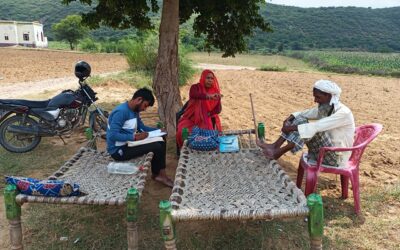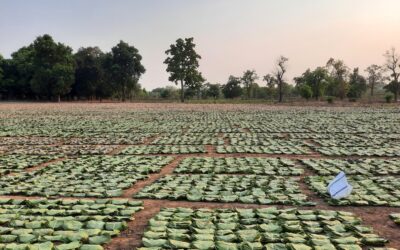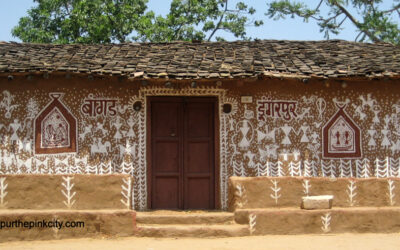Nature is considered a reflection of truth in the holy book of Quran. Hindu scriptures also emphasize on divinity contained in the elements of nature – Earth, Water, Fire, Air and Space. Religious books, the predominant source of values in any culture, recognize the importance of environment, inspiring us to live in harmony with nature.
Tribal communities in India have been exemplifying how religion and culture have been supporting the conservation of nature since a long time. The indigenous communities living in forests have conserved their regional biodiversity which sustains them. Poverty and illiteracy hardly hinder their brilliant understanding of ecosystem. Protection of nature and wildlife comes first, and these beliefs are evidently reflected in their festivals, folklore, arts and other cultural practices. Farmers who still use traditional farming techniques mainly depend upon the livestock.
During my first visit to Purushwadi, a tribal village in Akole Taluka of Ahmednagar, Maharashtra, on the eve of 21st August, Mahadeo Koli tribe of the village was celebrating Bail Pola, the festival of human-animal relationship. It’s the village famous for its firefly festival. My host organization, Grassroutes Journeys, had established its first Rural Tourism model here in 2007 to create livelihood opportunities in the village through sustainable and responsible tourism.
Introduction
Bail (bullock) Pola is a festival celebrated widely during monsoon season by farmers of Maharashtra and Chhattisgarh. On the new moon day of Shravana month as per the Hindu calendar (late August or early September by Gregorian calendar), farmers decorate and worship their bulls. This day is also known as Kushopatini Amavasya or Pithori Amavasya. Pitha, in Marathi means flour. It is believed that on this night, the sky looks as if wheat flour is spread all over it. The farmers show their gratitude to their bulls for helping them. The word Pola also has its own share of stories associated with it. They say that on this day, Lord Krishna, as a child, was attacked by a demon Polasur who was sent by Krishna’s maternal uncle Kansa. Eventually, Lord Krishna killed the demon.
Celebration
The villagers of Purushwadi begin the preparation of festival 2-3 days in advance. The market in Rajur, a small town about 9 km from Purushwadi, becomes a profusion for decorative items, colors, bullock idols, toys, bullock head-gear and other ornaments for bulls. It suddenly becomes a beautiful place to visit. Farmers from the nearby villages come with their families. On the day of the festival, every family starts with the traditional ritual of taking their bulls to water streams. They massage its shoulders with turmeric paste and homemade white butter. They are washed from horns to tail. After returning, bulls’ horns and bodies are painted. Kids are gifted a wooden toy in the shape of Bull, called ‘Bailjodi’.
Around 4 pm, a few villagers come out with their drums and start beating them at the entrance of the village. This is a signal for everyone to bring their bulls. Within minutes, a huge crowd of farmers gathers with their bulls. They walk towards temple ground where each family chooses a place and starts decorating their bulls. Crown like head-gear is fitted to the horns, garlands are tied to their necks and flanks; colorfully quilted and embroidered ‘coats’ are worn on their backs and ornaments, specially made for Pola festival are adorned on the bulls. One by one, farmers took them to the temple gate for prayers.

Bulls are then made to stand on the sides of the road, facing each other. As the sound of drum beating rises, women come out of homes with Diya (lamps) and Kumkum (vermilion). They worship all the bulls.
 Amidst all this, one of the villager brings Lejhim, a small musical instrument with jingling cymbals used by people in Maharashtra while performing folk dances of Lejhim and Lavani. Women worship the instrument while men just pick one each and gather in a circle to dance on folk songs and prayers. While they continue dancing for hours, women stand at a corner, giggling.
Amidst all this, one of the villager brings Lejhim, a small musical instrument with jingling cymbals used by people in Maharashtra while performing folk dances of Lejhim and Lavani. Women worship the instrument while men just pick one each and gather in a circle to dance on folk songs and prayers. While they continue dancing for hours, women stand at a corner, giggling.
Later, it was time to test the bond between farmers and their bulls. Each farmer tries to make his bull sit on the ground by his command. When nobody except one was able to do it, he was declared the winner. With this, the festive celebration at the common ground comes to an end and everyone goes back home. Those who do not have bulls, bring their idols and worship them at home.
Food
Women cook scrumptious festive food for dinner. There are traditional Maharashtrian delicacies like Puran poli, Karanji, Khichadi, and Bhakari, out of which Puran Poli is my favorite. It’s a sweet flatbread made from split yellow gram, plain flour, jaggery and cardamom powder served with jaggery sauce, milk, rice papad and amti (gravy of the yellow gram), topped with ghee (homemade butter).
Learning
It was awe-striking to watching the celebration. A one-of-its-kind festival where you get to witness a farmer’s love for his cattle. After returning to my home in Mumbai, I called up my father who is also a farmer. Overwhelmed by hearing the stories, he replied, “Cattle becomes the part of the farmer’s family, not just because they help on farms, but also because of all the love they give back.”
However, in many parts of our country, animals are exploited for use. Practices of prodding the cattle with sharp stick and extreme bending of their tails are common. There have been cases where cows and bulls have been fed alcohol, or chili pepper has been rubbed in their eyes to aggravate them in the name of traditional sports. Clearly, it cannot be classified as an act of humanity.
As Mahatma Gandhi said,
“The greatness of a nation and its moral progress can be judged by the way its animals are treated”.
It’s essential to develop empathy towards animals, specially by the youth of our country. It will be a key step towards creating a socially and physically friendly environment for animals as well as humans.










0 Comments